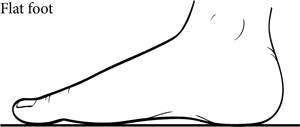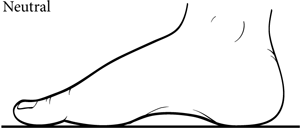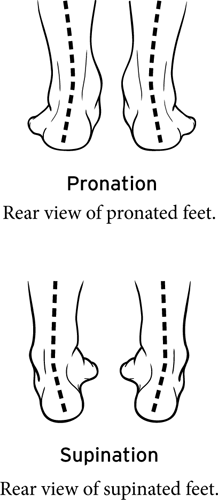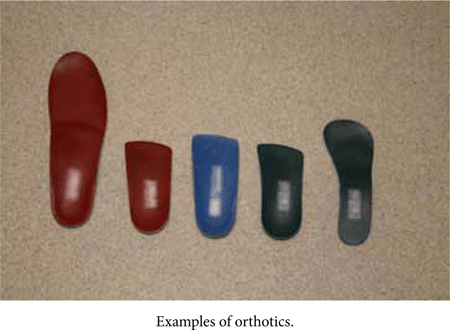Sports & Exercise
Orthotics (Care of the Young Athlete)
Print, Share, or View Spanish version of this article
Orthotics are shoe inserts that are designed to
provide cushioning, support, stability, and/or relief to pressure areas of the
foot. They can be soft, semi-rigid, accommodative, or rigid; they can be
custom-made from a mold or impression of the foot or bought by size “off
the shelf.”
Orthotics are used to treat foot and leg problems
caused by foot abnormalities or variations in foot structure, like a flat foot
or foot with a high arch. They can also be used to treat leg injuries where the
foot structure may be a contributing factor. How well an orthotic works depends
on the fit, the design, and if it is being used correctly. (Note: Other
treatments for the condition also may affect recovery.)
Mechanics of walking and running
When walking or running, the foot undergoes
pronation and supination. Everyone pronates and everyone supinates. However,
when pronation or supination is excessive, injury may occur.
Pronation occurs when the foot
lands on the ground. The arch flattens, the heel flares out, and the shin bone
rotates inwardly. This allows the foot to absorb shock and adapt to the
surface.
A flat foot pronates excessively. Even if the
foot appears to have an arch, excessive pronation results in the arch collapsing
with weight bearing. Due to the instability of a pronated (flat) foot, the leg
muscles have to work extra hard to stabilize the foot during walking or running.
This can cause shin splints and stress fractures. A flat foot also is associated
with increased internal tibial rotation (when the knee turns inward) and can
lead to patellar tracking problems and overuse injuries of the knee. An orthotic
that supports the arch can help treat these conditions.
Supination happens before pushing
off with walking or running. Supination raises the arch, inverts the heel, and
makes the foot more rigid to allow for push-off.
A foot with a high arch is rigid and supinates.
This foot type has stability and support but lacks flexibility for shock
absorption. This rigidity can lead to stress fractures or overuse injuries. A
rigid orthotic for this foot type is not recommended because it may actually
increase the risk of injury, but a shoe or insert that provides cushion may be
helpful.
Orthotics and foot type
| Foot Type | Foot Characteristics | Orthotic Recommendation |
|---|---|---|

|
Flexible, adaptable, good shock absorption; associated with internal rotation of shin bone and patellar tracking problems; can lead to overworking of the leg muscles that help stabilize the foot |
Rigid or semi-rigid orthotic designed for motion control, stability, and hind foot control. |

|
Average level of stability and shock absorption | No orthotic needed if a stable and supportive shoe is available. May need neutral, accommodative orthotic in a cleated shoe (like a soccer shoe). |

|
Rigid, poor shock absorption; contributes to overload of the
tibia and leg muscles |
Cushioned shoe or shock-absorbing insole. |
Orthotics and treatment of foot conditions
| Conditions | Type of Orthotic | Comment |
|---|---|---|
| Painful accessory navicular (extra bone on inner part of the foot that becomes painful when arch flattens) |
Non-rigid arch support | Preventing the arch from collapsing will decrease stress on the painful bone. |
| Sever’s disease (pain in the growth plate of the heel where the Achilles tendon and plantar fascia attach) |
Heel cup and/or heel lift along with a shoe with built-in arch support |
The heel lift is most important, but combining it with an arch support is useful if flat foot is present. |
| Chondromalacia of patella (soft cartilage behind the knee cap) |
Neutral arch support | Flat feet can contribute to abnormal patellar tracking. Goal is to control the internal tibial rotation associated with flat foot. |
| Shin splints (with flexible, flat foot) | Neutral arch support | A flat foot needs control and stability to relieve stress on leg muscles. |
| Shin splints (foot with rigid, high arch) | Cushion; shock-absorbing insole | A rigid foot transmits more stress to the leg. A cushioned orthotic can relieve stress on leg muscles. |
| Sesamoiditis (pain in small bones under big toe) | Arch support with extension under the first toe; cutout area for sesamoid |
The orthotic should shift the stress away from the painful sesamoid. |
| Tarsal coalition (abnormal fusion between bones in foot) | Neutral arch support | This is a rigid flat foot. An arch support can relieve pain at the abnormal joint. |
| Achilles tendonitis | Arch support if the foot is flat; heel lift if the foot has a high arch |
Depending on foot type, the orthotic should either control bending/torsion on the Achilles (with flat foot) or decrease tension on the Achilles (with high arch). |
Is an orthotic right for you?
An orthotic is just a tool to be used in the
treatment of specific injuries. There is no clear evidence that it can prevent
injuries. However, an incorrect orthotic can cause or worsen an injury. An
orthotic will not change a flat foot to a normal foot over time.
In deciding if an orthotic is a useful part of
the treatment, you should ask
-
Is the injury caused by a problem with
the structure of the foot? -
Can an orthotic correct this
problem? -
What other options are available to
treat the condition besides orthotics? Is there a shoe or
over-the-counter product that would work? -
What are the risks of using an orthotic?
Could it cause other injuries?
Photo courtesy of





